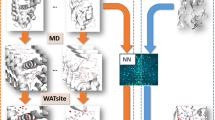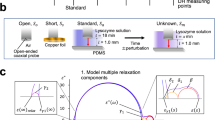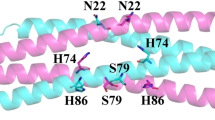Abstract
Here we present a comparative study of the stability of several proteins in H2O and D2O as a function of pH/pH*. We show that the substitution of D2O for H2O leads to an increase in the transition temperature and a decrease in the enthalpy of unfolding. The stability of the proteins, however, appears to be largely unchanged as a result of entropic compensation for the decrease in enthalpy. This enthalpy-entropy compensation is attributed to changes in hydration of proteins in D2O compared to H2O. Analysis of thermodynamic data for the transfer of model compounds from H2O to D2O shows that almost all the changes in the enthalpy of unfolding and in the protein-ligand interactions due to water isotopic substitution can be rationalized by changes in hydration of the buried non-polar groups.
This is a preview of subscription content, access via your institution
Access options
Subscribe to this journal
Receive 12 print issues and online access
$259.00 per year
only $21.58 per issue
Buy this article
- Purchase on SpringerLink
- Instant access to full article PDF
Prices may be subject to local taxes which are calculated during checkout
Similar content being viewed by others
References
Eisenberg, D. & McLachlan, A.D. Solvation energy of protein folding and binding. Nature 319, 199–203 (1986).
Dill, K.A. Dominant forces in protein folding. Biochemistry 29, 7133–7155 (1990).
Pace, C.N. Contribution of the hydrophobic effect to globular protein stability. J. molec. Biol. 226, 29–35 (1992).
Yang, A.S., Sharp, K.A. & Honig, B. Analysis of the heat capacity dependencies of protein folding. J. molec. Biol. 227, 889–900 (1992).
Spolar, R.S. & Record, Jr., M.T. Coupling of local folding to site-specific binding of proteins to DNA. Science 263, 777–784 (1994).
Baldwin, R.L. Temperature dependence of the hydrophobic interaction in protein folding. Proc. natn. Acad. Sci. U.S.A. 83, 8069–8072 (1986).
Privalov, P.L. & Gill, S.J. Stability of protein structure and hydrophobic interactions. Adv. Protein Chem. 39, 191–234 (1988).
Ben-Naim, A. Solvent effects on protein association and protein folding. Biopolymers 29, 567–596 (1990).
Makhatadze, G.I. & Privalov, P.L. Energetics of protein structure. Adv. Protein Chem. 47, 307–425 (1995).
Nemethy, G. & Scheraga, H.A. Structure of water and hydrophobic bonding in proteins. IV. Thermodynamic properties of liquid deuterium oxide. J. chem. Phys. 41, 680–689 (1964).
Marcus, Y. & Ben-Naim, A. A study of the structure of water and its dependence on solutes based on the isotope effects on solvation thermodynamics in water. J. chem. Phys. 83, 4744–4759 (1985).
Arnett, E.M. & McKelvey, D.R. Solvent isotope effect on thermodynamics of nonreacting solutes. in Solute-Solvent Interactions, (J. F. Coetzee & C.D. Ritchie, Eds.) 343–398 (Marcel Dekker, New York & London; 1969).
Lumry, R. & Rajender, S. Enthalpy-entropy compensation phenomena in water solutions of proteins and small molecules: a ubiquitous property of water. Biopolymers 9, 1125–1227 (1970).
Dahlberg, D.B. Aqueous solution structure as determined from thermodynamic parameters of transfer from water to heavy water. J. phys. Chem. 76, 2045–2050 (1972).
Ben-Naim, A., Wilf, J. & Yaacobi, M. Hydrophobic interaction in light and heavy water. J. phys. Chem. 77, 95–102 (1975).
Scharlin, P. & Battino, R. Solubility of 13 nonpolar gases in deuterium oxide at 15-45°C and 101. 325 kPa. J. Solution Chem. 21, 67–91 (1992).
Kresheck, G.C., Schneider, H. & Scheraga, H.A. The effect of D2O on the thermal stability of proteins. Thermodynamic parameters of the transfer of model compounds from H2O to D2O. J. phys. Chem. 69, 3132–3144 (1965).
Connelly, P.R., Thomson, J.A., Fitzgibbon, M.J., Bruzzese, F.J. Probing hydration contribution to the thermodynamics of ligand binding by proteins. Enthalpy and heat capacity changes of tacrolimus and rapamycin binding to FK506 binding protein in D20 and H20. Biochemistry 32, 5583–5590 (1993).
Hallen, D., Nilsson, S.-O., Rothschild, W., Wadso, I. Enthalpies and heat capacities for n-alkan-1-ols in H2O and D2O. J. chem. Thermodynamics 18, 429–442 (1986).
Chervenak, M.C. & Toone, E.J. A direct measure of the contribution of solvent reorganization to the enthalpy of ligand binding. J. Am. chem. Soc. 116, 10533–10539 (1994).
Glasoe, P.K. & Long, F.A. Use of glass electrodes to measure acidities in deuterium oxide. J. phys. Chem. 64, 188–190 (1960).
Bundi, A. & Wüthrich, K. 1H-NMR parameters of the common amino acid residues measured in aqueous solutions of the linear tripeptides H-Gly-Gly-X-L-Ala-OH. Biopolymers 18, 285–297 (1979).
Makhatadze, G.I. & Privalov, P.L. Protein interaction with urea and guanidinium chloride. A calorimetric study. J. molec. Biol. 226, 491–505 (1992).
Makhatadze, G.I., Clore, G.M., Gronenborn, A.M. & Privalov, P.L. Thermodynamics of unfolding of all β-sheet protein interteukin-1 β. Biochemistry 33, 9327–9332 (1994).
Lee, B.K. & Richards, F.M. The interpretation of protein structure: estimation of static accessibility. J. molec. Biol. 55, 379–400 (1971).
Chothia, C. The nature of accessible and buried surfaces in proteins. J. molec. Biol. 105, 1–14 (1976).
Bernstein, F.C. et al. The Protein Data Bank: A computer-based archival file for macromolecular structures. J. molec. Biol. 112, 535–542 (1977).
Naismith, J.H. et al. Refined structure of concanavalin-A complex with α-methyl-D-mannopyranoside at 2.0 Å resolution and comparison with the saccaride free structure. Acta. crystallogr. Sect. D. 50, 847–852, (1994).
van Duyne, G.D., Standaert, R.F., Karplus, P.A., Schreiber, S.L. & Clardy, J. Atomic structure of FKBP-FK506, an immunophilin-immunosuppressant complex. Science 252, 839–842 (1991).
Privalov, P.L. & Makhatadze, G.I. Contribution of hydration and non-covalent interactions to the heat capacity effect on protein unfolding. J. molec. Biol. 224, 715–723 (1992).
Connelly, P.R., et al., Enthalpy of hydrogen bond formation in a protein-ligand binding reaction. Proc. natn. Acad. Sci. U.S.A. 91, 1964–1968 (1994).
Author information
Authors and Affiliations
Rights and permissions
About this article
Cite this article
Makhatadze, G., Clore, G. & Gronenborn, A. Solvent isotope effect and protein stability. Nat Struct Mol Biol 2, 852–855 (1995). https://doi.org/10.1038/nsb1095-852
Received:
Accepted:
Published:
Issue date:
DOI: https://doi.org/10.1038/nsb1095-852
This article is cited by
-
Macromolecular condensation buffers intracellular water potential
Nature (2023)
-
Monitoring allostery in D2O: a necessary control in studies using hydrogen/deuterium exchange to characterize allosteric regulation
Analytical and Bioanalytical Chemistry (2011)



